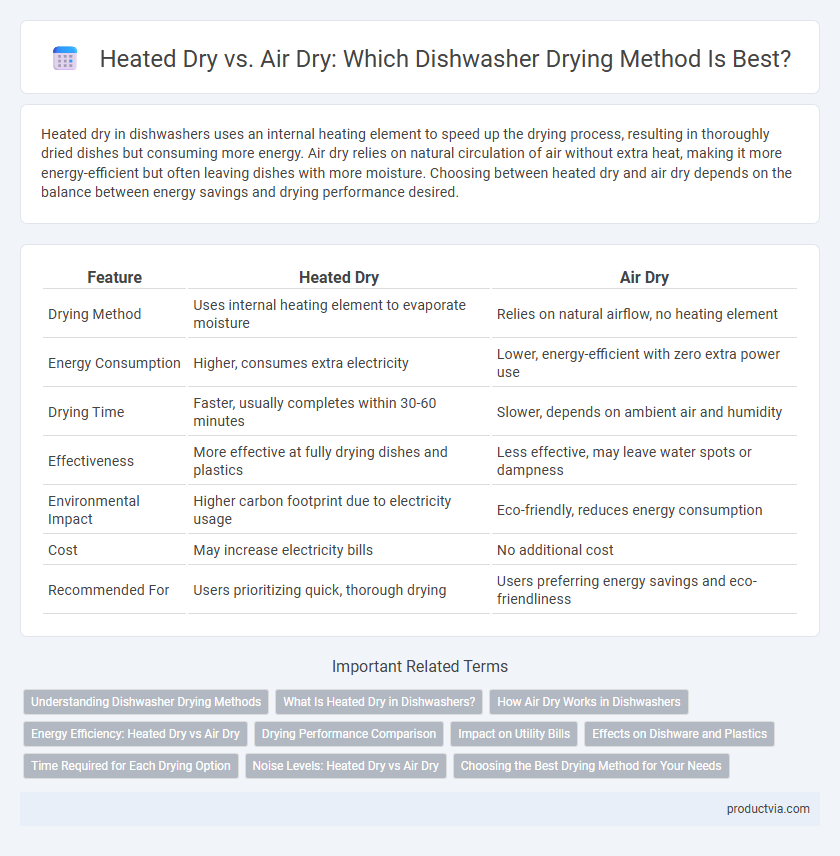Heated dry in dishwashers uses an internal heating element to speed up the drying process, resulting in thoroughly dried dishes but consuming more energy. Air dry relies on natural circulation of air without extra heat, making it more energy-efficient but often leaving dishes with more moisture. Choosing between heated dry and air dry depends on the balance between energy savings and drying performance desired.
Table of Comparison
| Feature | Heated Dry | Air Dry |
|---|---|---|
| Drying Method | Uses internal heating element to evaporate moisture | Relies on natural airflow, no heating element |
| Energy Consumption | Higher, consumes extra electricity | Lower, energy-efficient with zero extra power use |
| Drying Time | Faster, usually completes within 30-60 minutes | Slower, depends on ambient air and humidity |
| Effectiveness | More effective at fully drying dishes and plastics | Less effective, may leave water spots or dampness |
| Environmental Impact | Higher carbon footprint due to electricity usage | Eco-friendly, reduces energy consumption |
| Cost | May increase electricity bills | No additional cost |
| Recommended For | Users prioritizing quick, thorough drying | Users preferring energy savings and eco-friendliness |
Understanding Dishwasher Drying Methods
Heated dry uses an internal heating element to evaporate water from dishes, providing faster and more thorough drying, especially on plastic items. Air dry relies on residual heat and external air circulation without additional energy usage, promoting energy efficiency but may leave some moisture on dishes. Understanding these methods helps optimize drying performance and energy consumption based on dishwasher models and user preferences.
What Is Heated Dry in Dishwashers?
Heated dry in dishwashers uses an internal heating element to raise the temperature inside the appliance, accelerating moisture evaporation from dishes. This method ensures dishes come out thoroughly dry and spot-free, especially effective for plastic items that retain water more easily. Although heated dry consumes more energy than air dry, it significantly reduces the need for manual towel drying and improves overall dish hygiene.
How Air Dry Works in Dishwashers
Air dry in dishwashers functions by opening the door slightly at the end of the wash cycle, allowing moisture to evaporate naturally without using extra energy. This method relies on ambient air circulation and the residual heat of the dishes to speed up drying. Air drying reduces electricity consumption compared to heated dry, making it an eco-friendly option for energy-conscious users.
Energy Efficiency: Heated Dry vs Air Dry
Heated dry in dishwashers consumes substantially more energy than air dry, using electric heating elements to evaporate moisture quickly. Air dry methods rely on natural evaporation or the dishwasher's venting system, significantly reducing electricity usage and lowering utility costs. Choosing air dry over heated dry can improve a dishwasher's overall energy efficiency and contribute to more sustainable household practices.
Drying Performance Comparison
Heated dry in dishwashers uses high temperatures to evaporate moisture, resulting in superior drying performance, especially for plastic and hard-to-dry items. Air dry relies on natural ventilation or a fan to circulate air, which consumes less energy but often leaves dishes with water spots or dampness. Studies show heated dry cycles enhance overall drying efficiency by 30-50% compared to air dry settings, making it a preferred choice for optimal cleanliness.
Impact on Utility Bills
Heated dry in dishwashers consumes significantly more electricity, leading to higher utility bills compared to air dry, which relies on natural evaporation and residual heat. Energy usage from heated drying can increase a household's monthly electricity cost by up to 15%, while air dry offers a more cost-effective, energy-efficient alternative. Choosing air dry reduces overall energy consumption, contributing to lower utility expenses and a smaller environmental footprint.
Effects on Dishware and Plastics
Heated dry in dishwashers effectively removes moisture by using high temperatures, which can cause warping or damage to heat-sensitive plastics and may fade delicate dishware over time. Air dry relies on natural evaporation without added heat, preserving the integrity of plastics and fragile items while potentially leaving water spots on glassware and dishes. Choosing air dry extends the lifespan of plastic containers and delicate ceramics but may require a longer drying time compared to heated dry cycles.
Time Required for Each Drying Option
Heated dry in dishwashers typically requires 20 to 40 minutes, using electric heating elements to evaporate moisture quickly and ensure dishes are thoroughly dried. Air dry options rely on natural evaporation, often taking 1 to 3 hours depending on ambient humidity and dishwasher ventilation, making it a slower but more energy-efficient method. Choosing between heated dry and air dry affects cycle length and energy consumption, with heated dry providing faster results.
Noise Levels: Heated Dry vs Air Dry
Heated dry cycles in dishwashers typically produce more noise due to the electrical heating element actively generating heat, which can create a humming or buzzing sound. Air dry options rely on natural airflow or the dishwasher's fan, often resulting in quieter operation, making them preferable for noise-sensitive environments. Choosing air dry can significantly reduce the overall noise levels during the drying phase without compromising drying effectiveness.
Choosing the Best Drying Method for Your Needs
Heated dry cycles in dishwashers utilize electric heating elements to evaporate moisture quickly, ensuring dishes come out fully dry and free of water spots, ideal for plastic and lightweight items. Air dry methods rely on natural convection without extra energy, reducing electricity usage and preventing heat damage to delicate glassware or plastics prone to warping. Selecting between heated dry and air dry depends on your priority for energy efficiency versus drying performance tailored to your typical dishware and environmental concerns.
Heated dry vs air dry for dishwasher drying Infographic

 productvia.com
productvia.com